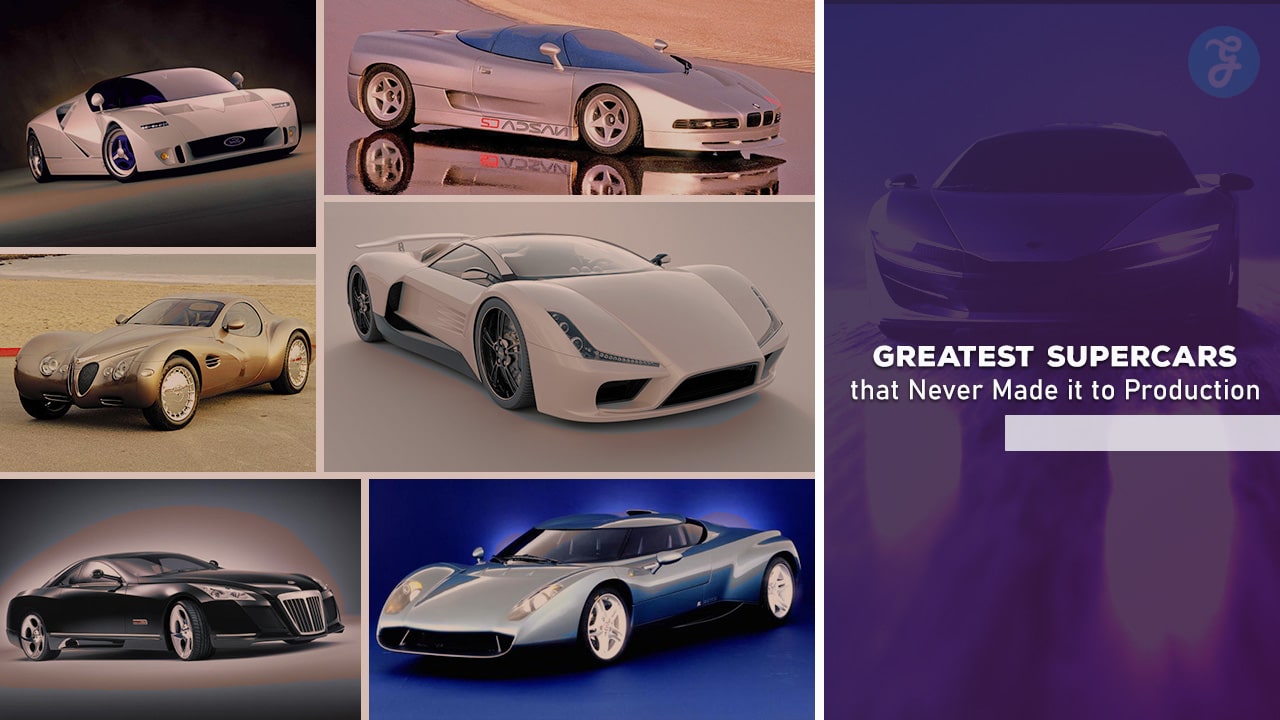Supercars captivate car enthusiasts with their stunning designs and incredible performance. Yet some of the most amazing supercars never actually made it to production. These concept cars and prototypes pushed the limits of automotive engineering but remained dreams that never became reality.
Many factors can prevent an exciting supercar concept from reaching production, including high costs, technical challenges, or changes in company strategy.
You’ll be amazed by the innovative designs and cutting-edge technology featured in these supercars that almost were.
From scissor doors to mid-engine layouts, these vehicles showcased bold ideas that influenced future production cars, even if they didn’t make it to showrooms themselves.
1. Jaguar C-X75
The Jaguar C-X75 was a stunning supercar that never hit the roads. Unveiled in 2010, it wowed car enthusiasts with its sleek design and innovative technology.
You might wonder what made the C-X75 special. It combines jaw-dropping looks with cutting-edge hybrid power. Jaguar planned to use a mix of electric motors and a petrol engine to create a true performance beast.
The C-X75 promised incredible speed. It could zoom from 0 to 60 mph in under 3 seconds. Top speed? A mind-blowing 205 mph. These numbers put it in the same league as the fastest supercars.
Jaguar teamed up with Williams F1 to develop the C-X75. This partnership brought racing expertise to the project. The goal was to make a road car with F1-level tech.
Sadly, the C-X75 never made it to production. Jaguar canceled the project in 2012. The global economic crisis played a big role in this decision.
Only five prototypes were built. These rare cars give us a glimpse of what could have been. The C-X75 remains a dream car for many Jaguar fans.
2. Lamborghini Asterion
The Lamborghini Asterion was a concept car that got supercar fans excited. Unveiled in 2014, it promised incredible performance and a unique design.
You might wonder what made the Asterion special. It was Lamborghini’s first plug-in hybrid supercar. The car combined a V10 engine with three electric motors, producing a whopping 910 horsepower.
The Asterion’s looks were just as impressive as its power. It had sleek lines and a low profile, typical of Lamborghini’s style. But it also included some unexpected comfort features.
Unlike many supercars, the Asterion was designed as a grand tourer. This meant it had a more spacious interior and a 2+2 seating layout. You could have taken this supercar on long trips in comfort.
So why didn’t the Asterion make it to production? The company’s CEO at the time wasn’t a fan of hybrid technology. He believed Lamborghini should stick to traditional engines.
As a result, the Asterion remained a concept. You can only imagine how it might have changed Lamborghini’s lineup if it had been built.
3. Porsche 919 Street
The Porsche 919 Street was a thrilling concept that almost brought Le Mans racing technology to the road. This supercar was based on Porsche’s incredibly successful 919 Hybrid race car.
Imagine driving a car with 900 horsepower on public streets. That’s what the 919 Street promised. It kept the same hybrid powertrain as its racing counterpart.
The 919 Street’s design was sleek and aerodynamic. It featured a carbon-fiber monocoque body, just like the race car. This would have made it incredibly light and strong.
Porsche even created a clay model of the 919 Street. This shows how serious they were about potentially producing it. Sadly, it never made it past this stage.
Why didn’t Porsche build the 919 Street? The exact reasons aren’t clear. Maybe it was too expensive or complicated to make road-legal.
Despite never reaching production, the 919 Street has a devoted following. Many Porsche fans still ask about it, hoping it might one day become reality.
The 919 Street represents what could have been – a true racecar for the road. It’s a tantalizing glimpse of Porsche’s engineering prowess and racing heritage.
4. Aston Martin AM-RB 003
The Aston Martin AM-RB 003 is a stunning mid-engine supercar that never hit the streets. You might wonder why it’s so special. Well, it’s the third in a line of groundbreaking designs from Aston Martin.
Aston Martin teamed up with Red Bull Advanced Technologies to create this beast. They aimed to bring Formula 1 tech to the road. The AM-RB 003 was meant to be more practical than its track-focused siblings.
What made it stand out? Its sleek, aerodynamic body caught everyone’s eye. The car used lightweight materials and advanced engineering to boost performance. Under the hood, a hybrid powertrain promised incredible speed and efficiency.
Sadly, the AM-RB 003 stayed a concept. But it showed what Aston Martin could do with mid-engine designs. The car’s influence lives on in other Aston models you can see today.
Even though you can’t buy one, the AM-RB 003 left its mark. It pushed the limits of what a road car could be. It’s a dream machine that car fans still talk about.
5. Mazda Furai
The Mazda Furai was a stunning concept car that captured the imagination of car enthusiasts worldwide. Unveiled in 2008, it represented the pinnacle of Mazda’s Nagare design language.
The Furai’s name means “sound of the wind” in Japanese, and its sleek bodywork lived up to this poetic moniker. Its low-slung profile and dramatic curves made it look like a vehicle from the future.
Under the hood, the Furai packed a rotary engine running on ethanol fuel. This 450-horsepower powerplant gave the concept car impressive performance potential.
Unlike many concept cars, the Furai was fully functional. Mazda even tested it on race tracks, showcasing its capabilities beyond just looking good on a show stand.
Sadly, the Furai’s story ended in tragedy. During a test run in 2008, the only example caught fire and was destroyed. This loss meant the Furai would never see production.
Despite its short life, the Furai left a lasting impact on car design. Its influence can be seen in later Mazda models and other sports cars. The Furai remains a symbol of what might have been in the world of supercars.
6. BMW M8 E31
The BMW M8 E31 is a supercar that never made it to production. You might wonder why BMW didn’t release this powerful machine.
The M8 was based on the 8 Series coupe from the 1990s. It had a special 6.0-liter V12 engine. This monster motor could produce an incredible 640 horsepower.
BMW gave the M8 some unique features. It had a carbon fiber body to keep weight down. The interior was stripped out for better performance.
The car’s top speed was said to be around 190 mph. This would have made it one of the fastest cars of its time.
So why didn’t BMW build it? The company felt it was too extreme for the market. They worried it might not sell well enough.
Instead, BMW released the 850CSi. This was a tamer version of the M8 concept. It still had a V12, but with “only” 375 horsepower.
The M8 remains a “what if” in BMW’s history. It shows how far the company was willing to push performance in the 1990s.
7. Volvo S60 Polestar Concept
The Volvo S60 Polestar Concept was a high-performance sedan that caught the eye of car enthusiasts. Unveiled in 2012, it showcased Volvo’s potential in the sports car market.
Under the hood, this concept packed a punch. It boasted a turbocharged 3.0-liter inline-six engine producing 508 horsepower. This power allowed the car to zoom from 0 to 60 mph in just 3.9 seconds.
The exterior sported a sleek, widebody design. Its striking Rebel Blue paint made it stand out. Aerodynamic upgrades improved its performance and gave it a more aggressive look.
Inside, the S60 Polestar Concept featured a mix of luxury and sportiness. Alcantara and carbon fiber accents adorned the cabin. The seats offered both comfort and support for spirited driving.
While the concept never reached full production, it did inspire future Volvo models. You can see its influence in the current Polestar performance lineup. The S60 Polestar Concept showed that Volvo could create exciting, high-performance vehicles.
8. Cadillac Sixteen
The Cadillac Sixteen was a concept car that turned heads when it debuted in 2003. It was a bold vision of luxury and power that never made it to production.
You might wonder what made the Sixteen so special. Its standout feature was the massive 13.6-liter V16 engine under its long hood. This powerplant was a nod to Cadillac’s legendary V16 models from the 1930s.
The Sixteen’s design was equally impressive. It boasted a sleek, elongated body with classic Cadillac styling cues. The car stretched nearly 19 feet long and rode on massive 24-inch wheels.
Inside, the Sixteen offered unmatched luxury. The interior featured hand-stitched leather, polished aluminum, and rich wood trim. It could comfortably seat four passengers in opulent surroundings.
Despite its appeal, the Sixteen never reached showrooms. The high costs and complexities of producing such an extravagant vehicle likely prevented its manufacture.
The Cadillac Sixteen remains a “what if” moment in automotive history. It showed what Cadillac could achieve when pushing the boundaries of luxury and performance.
9. Mercedes-Benz C112
The Mercedes-Benz C112 was a stunning supercar that never hit the streets. It wowed car lovers in 1991 with its sleek design and cutting-edge tech.
This one-of-a-kind marvel packed a powerful punch. Under the hood, it boasted a 6.0-liter V12 engine that could zoom from 0 to 62 mph in just 4.9 seconds.
The C112’s looks were way ahead of its time. Its smooth curves and gull-wing doors turned heads everywhere. Inside, you’d find a luxurious mix of black and gray leather.
Mercedes stuffed this car with high-tech goodies. It had active suspension, rear-wheel steering, and even active aerodynamics. These features made it super stable and fun to drive.
Sadly, only one C112 was ever built. Despite huge interest from buyers, Mercedes decided not to make more. They kept the sole model for their own collection.
The C112 showed what Mercedes could do when they let loose. It pushed the limits of car tech and design. Even today, it stands out as a symbol of what could have been in the supercar world.
10. Chevrolet Chaparral 2X Vision GT
The Chevrolet Chaparral 2X Vision GT is a mind-blowing concept car that pushes the limits of automotive design. Unveiled at the 2014 Los Angeles Auto Show, this futuristic vehicle was created for the popular racing game Gran Turismo 6.
You won’t believe the performance specs of this virtual supercar. It can reach a top speed of 240 mph and accelerate from 0-60 mph in just 1.5 seconds. That’s faster than most supercars can even dream of!
The Chaparral 2X Vision GT’s most unique feature is its powertrain. Instead of a typical engine, it uses a fictional laser propulsion system. This imaginary tech gives the car an incredible 900 horsepower.
Chevy designed the Chaparral 2X Vision GT to recreate the feeling of flying in a wingsuit. The driver lies face-down in the car, with their arms and legs spread out. This unusual position lets you feel like you’re really flying around the track.
While it never hit real roads, the Chaparral 2X Vision GT shows off Chevy’s creative thinking. It takes inspiration from Moto GP bikes and experimental race cars. The result is a wild machine that exists only in the digital world.
History of Supercars
Supercars have captivated car fans for decades with their stunning looks and amazing speed. These high-performance machines have come a long way since their early days.
Evolution Over the Decades
In the 1960s, cars like the Lamborghini Miura changed the game. It was one of the first mid-engine supercars. The 1970s saw more exotic designs like the Lancia Stratos and Lamborghini Countach.
In the 1980s, the Ferrari F40 and Porsche 959 pushed the limits of speed. The 1990s brought icons like the McLaren F1, which held the production car speed record for years.
The 2000s saw hybrid tech enter supercars. The Ferrari LaFerrari and McLaren P1 combined electric motors with gas engines for insane power. Today’s supercars use even more advanced tech to go faster than ever.
Pioneering Technologies
Supercars have always been test beds for new car tech. Many features you see in regular cars today started in supercars.
Carbon fiber was first used widely in F1 cars and supercars before trickling down. Active aero, which changes a car’s aerodynamics on the fly, debuted on the Porsche 959 in the 1980s.
Dual-clutch transmissions, now common in sports cars, were pioneered in racing and supercars. Today, electric powertrains are being perfected in top-end performance cars before wider use.
Advanced driver aids and safety tech also often debut in supercars before reaching mainstream cars.
Challenges in Bringing Supercars to Production
Making supercars isn’t easy. Money, tech, and rules can stop amazing cars from hitting the road. Let’s look at what gets in the way.
Financial Constraints
Building supercars costs a ton of cash. You need big money for design, testing, and fancy materials. Many cool ideas die because there’s not enough funding.
Small companies often struggle to find investors. Big car makers might not want to risk millions on a wild design. The Audi R8 Le Mans Concept is a good example. It had a powerful diesel engine but never made it past the concept stage.
Sometimes, the market is too small. Supercars are pricey, so not many people can buy them. This makes it hard to earn back the money spent on making them.
Technical Hurdles
Supercars push the limits of what’s possible. This can lead to big tech problems. Engineers have to solve tricky issues with engines, aerodynamics, and safety.
New materials like carbon fiber are tough to work with. They’re light and strong, but hard to mass-produce. This slows down production and drives up costs.
Cooling is another big challenge. High-power engines make lots of heat. Designers have to find smart ways to keep everything cool without messing up the car’s looks.
Balancing performance and reliability is tough too. A supercar needs to be fast and safe. Getting this mix right takes time and lots of testing.
Regulatory Roadblocks
Rules and laws can kill a supercar project. Safety standards keep getting stricter. This means more crash tests and expensive safety gear.
Emission rules are a big deal too. Many cool engine ideas don’t meet pollution limits. The Citroen Osée concept, with its powerful V6, might have faced this issue.
Different countries have different rules. This makes it hard to sell supercars worldwide. Companies have to change designs for each market, which costs more money.
Noise laws can also be a problem. Supercars are known for their roar, but some places have strict noise limits. This forces designers to quiet down their creations.
Final Thoughts
In the world of automotive excellence, not all dreams make it to reality.
The 10 greatest supercars that never made it to production serve as a testament to the boundless creativity and ambition of car manufacturers. These vehicles, with their innovative designs and groundbreaking technology, represent the pinnacle of what could have been—pushing the boundaries of performance and aesthetics.
Despite never seeing the open road, they left an indelible mark on the industry, influencing future designs and inspiring car enthusiasts worldwide.
These lost dreams remind us that while not every concept reaches production, the pursuit of automotive perfection continues to drive innovation forward, keeping the spirit of these incredible machines alive in the hearts of car lovers everywhere.








































